Varicose veins can appear on different parts of the body, but the most common are varicose veins on the lower legs. This disease is characterized by a violation of the outflow of blood, which stagnates in the leg veins. In medicine, varicose veins on the lower legs are interpreted as a disease accompanied by an increase in length, the appearance of serpentine tortuosity in the saphenous veins, as well as a sac-like increase in their lumen. This disease is recorded in 17-25% of the population. Moreover, women are affected by this disease 3 times more often than men.
Cause of disease
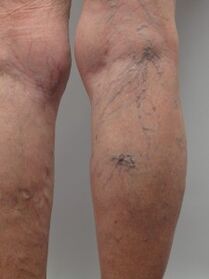
The main causes of this disease are:
- descent;
- old age;
- overweight;
- wearing tight, uncomfortable underwear, especially narrow high-heeled shoes.
The influence of heredity on the occurrence and development of varicose veins has not yet been proven. However, it is noted that some families have varicose veins quite often in several generations. It is noted that the main factors in the onset of the disease are nutrition, a specific lifestyle, and changes in the hormonal cycle.
The main risk factor in the development of this disease is obesity, and the incidence of varicose veins increases depending on the severity of obesity.
Being overweight is accompanied by an inactive lifestyle and irregular diet. For example, in the modern world, processed foods dominate, and there is a lack of use of plant fiber contained in raw vegetables, berries and fruits. Plant fiber is important for strengthening the vascular walls and lowering intra-abdominal pressure, which also helps reduce the risk of disease.
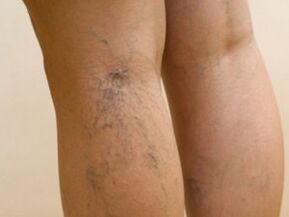
In addition to proper nutrition, the work process should be properly organized. As a rule, a person spends a significant period of working time in a standing or sitting position, which has an adverse effect on the function of the venous valve apparatus. Hard physical work associated with heavy loads on the legs when lifting heavy objects is considered equally unfavorable. Another risk factor that affects the development of this disease is a long trip or flight, which is accompanied by the appearance of blood stagnation in the leg veins.
Another major cause of this disease is fashion. Therefore, tight underwear compresses the veins in the inguinal fold area, and corsets significantly increase intra-abdominal pressure, which leads to varicose veins. Wearing high-heeled shoes is considered very dangerous, especially in combination with uncomfortable arch support.
A proven risk factor for venous disease is repeated pregnancy, which leads to changes in intra-abdominal pressure, while the hormone progesterone adversely affects the vein walls and destroys collagen and elastic fibers.
Symptoms of varicose veins on the lower legs
The main symptoms of this disease are:
- veins protruding from under the skin,
- swollen,
- pain in the legs, especially in the evening,
- tired
- changes in skin appearance - pigmentation, thickening,
- loss of skin elasticity, hair loss in the area where the dilated veins are located.
The main visible signs of varicose veins are dilation of the superficial veins like sacs or cylinders. Veins become unusually tortuous, protruding above the surface of the skin in the legs and feet. The largest varicose veins are repaired after long physical work.
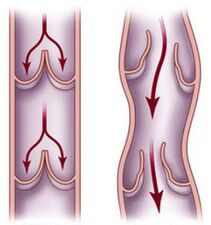
In the first stage of varicose veins, the symptoms are few and non-specific. The only symptom of this stage is a feeling of heaviness in the legs. Also worrying is rapid fatigue, burning sensation in the legs, which bothers after physical activity. Sometimes short-term swelling and pain occurs along the veins. Characterized by mild swelling of the dorsum of the foot and ankle, which often occurs in the evening after prolonged monotonous exercise. In the morning, the swelling disappeared without a trace, and the visible expansion of the veins was not observed.
If these signs appear, it is important to consult a specialist in time, this will prevent the development and progression of the disease. In the case of improper treatment, the neglected condition results in chronic venous insufficiency.
An important symptom of venous insufficiency is spider veins - a network of dilated capillaries (0. 1 mm or more) that can be seen through the skin. Women consider such "stars" as a cosmetic defect, but men do not notice it. Sometimes this is just a manifestation of hormonal disorders, abuse of the sauna or solarium. However, in most cases, spider veins are one of the first signs of vein congestion and the development of varicose veins. If there is a relatively small area of such disturbances on the skin, you should definitely consult a specialist.
Diagnosis of varicose veins
Vascular surgeons can diagnose varicose veins through routine examinations, venous ultrasound, and also using phlebography, which is the injection of a special drug into the vein and monitoring its reaction.
When you visit the doctor, you will be offered a special examination that consists of several procedures.
- Blood tests (general), which will show the degree of thickening, blood clotting (vulnerability to thrombosis), the presence or absence of inflammation (confirming thrombophlebitis).
- Vein ultrasound, which identifies the affected area. Vascular ultrasound is recommended to be performed to identify signs of varicose veins, even if spider veins have appeared.
- Rheovasography is a method that determines the inadequacy of blood supply (nutrition) to tissues by mathematical calculations. This is how the stage of the disease is determined, which is necessary to choose a treatment method.
- Surgical methods, such as venography (see above), are very rarely used to assess the state of the venous system.
Treatment methods for varicose veins
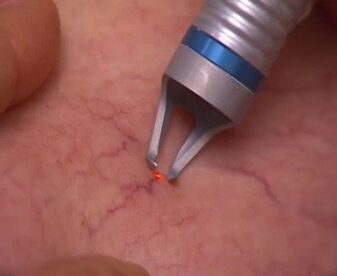
Treating varicose veins is quite difficult, so it is recommended to prevent them. Conservative treatment methods include tablets and special ointments prescribed by the doctor, wearing tights and stockings with special drawstrings. Surgical treatment of varicose veins is also possible, where the enlarged vein is removed from a person using a traction method. Laser therapy and sclerotherapy are considered very effective.
Varicose veins are of great concern to patients from a cosmetic point of view. Doctors consider it necessary to perform surgery. To reduce the risk of complications and speed up recovery, specialists prescribe special micronized drugs that help improve the tone in the veins, relieve inflammatory reactions and stimulate lymph flow.
Non-surgical treatment
Non-surgical treatment of varicose veins is only successful at the beginning of the disease, if the skin manifestations are mild, reducing the ability to work moderately. Conservative therapy is carried out if surgical treatment is contraindicated. This method is also mandatory for the post-operative period to avoid recurrence of the disease.
Conservative treatment is:
- reduce the influence of risk factors,
- adequate physical activity,
- elastic compression,
- medicines,
- use of physiotherapy.
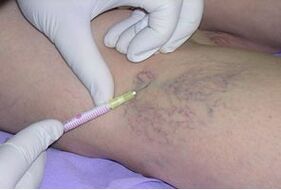
People with risk factors for developing varicose veins or a hereditary tendency should consult a phlebologist twice a year, undergo an ultrasound scan of the veins.
With conservative treatment, it is necessary to constantly train the veins, keep your feet elevated for a long time, and only wear comfortable and comfortable shoes.
Walking is indicated, as well as swimming or cycling. Physical activity should be carried out only under conditions of elastic compression. Elastic compression is a conservative method of treating varicose veins using elastic bandages or medical knitwear. It is contraindicated to engage in traumatic sports such as football, volleyball and others.
For varicose veins, it is recommended to use phlebotonic medicine. The action of the drugs is aimed at strengthening the vein walls.
All folk remedies, including medicinal herbs, will not be as effective as pharmaceutical drugs. You cannot self-medicate; any drug therapy is used only as prescribed by the doctor. Local treatment is carried out only if there is no thrombosis or thrombophlebitis.
Surgical treatment methods
Complete healing of varicose veins on the lower leg is achieved only with surgical treatment.
The following surgical treatment methods are used:
Phlebectomy- removal of varicose veins during surgery. This procedure is contraindicated if the patient has severe comorbidities or end-stage varicose veins.
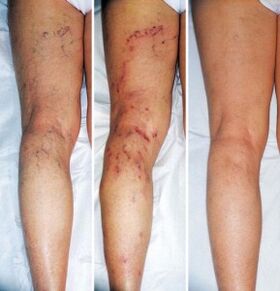 The operation is not performed during pregnancy, the presence of purulent processes in the body, or for the elderly.
The operation is not performed during pregnancy, the presence of purulent processes in the body, or for the elderly.The use of endoscopic treatment methods makes such operations as safe as possible, as well as cosmetically beneficial. The set of measures for the purpose of rapid recovery after surgery depends entirely on the complexity of the surgical procedure, while taking into account general principles. The final stitches are formed after 6 months, therefore, to avoid damage and cosmetic defects, it is necessary to exclude rough mechanical effects on them (use of hard sponges, tight clothes, uncomfortable). Do not wash with hot water. After surgery, elastic compression must be used for 6 months. In the future, compression socks will be needed for "harmful" loads (heavy lifting, long trips).
Sclerosis- injection into the vein of a special substance (sclerosant) that causes the vein wall to "stick" to stop blood flow. In this way, cosmetic defects are removed, because veins become invisible. This method is effective only when developing small branches of the main venous trunk. After the vein sclerosis procedure, the patient does not need rehabilitation.
Laser freezing— the destruction of the vein wall under the action of the laser, which causes the lumen of the vein to be "sealed. "Indicated for those whose vein dilatation is no more than 10 mm. The procedure requires anesthesia, initial patient activation and long-term elastic compression.
Prevention of varicose veins on the lower leg
Currently, great importance is attached to the prevention of varicose veins. It is necessary to regularly perform simple measures that can significantly reduce not only the risk of occurrence, but also the development and progression of the disease.
- An active lifestyle, measured by alternating long static loads with other types of physical activity, such as walking, running, cycling, swimming and doing light exercise at work.
- Keep your feet in a high position.
- Maintain a diet and monitor your weight.
- Wearing comfortable shoes with a heel size of no more than 4 cm, using orthopedic insoles is useful.
- When using estrogen, contraceptives, or during pregnancy, you should have an ultrasound scan of the lower leg veins.
Our health depends only on us, and to remain a happy person who is not bothered by any disease, it is important to carefully monitor your lifestyle, be physically active and eat right.























